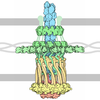[English] 日本語
 Yorodumi
Yorodumi- EMDB-62181: Cryo-EM structure of the Type II secretion system protein from Vi... -
+ Open data
Open data
- Basic information
Basic information
| Entry |  | |||||||||
|---|---|---|---|---|---|---|---|---|---|---|
| Title | Cryo-EM structure of the Type II secretion system protein from Vibrio cholerae | |||||||||
 Map data Map data | ||||||||||
 Sample Sample |
| |||||||||
 Keywords Keywords | Secretion / GspD / nanopore sequencing / PROTEIN TRANSPORT | |||||||||
| Function / homology |  Function and homology information Function and homology informationprotein secretion by the type II secretion system / type II protein secretion system complex / cell outer membrane / identical protein binding Similarity search - Function | |||||||||
| Biological species |  | |||||||||
| Method | single particle reconstruction / cryo EM / Resolution: 2.39 Å | |||||||||
 Authors Authors | Liu RH / Feng QS / Zhang K / Dai X / Dai J / Guo XR / Lin WF / Wang ZF / Fu Y / Li Y | |||||||||
| Funding support | 1 items
| |||||||||
 Citation Citation |  Journal: To Be Published Journal: To Be PublishedTitle: Cryo-EM structure of the Type II secretion system protein from Vibrio cholerae Authors: Liu RH / Feng QS / Zhang K / Dai X / Dai J / Guo XR / Lin WF / Wang ZF / Fu Y / Li Y | |||||||||
| History |
|
- Structure visualization
Structure visualization
| Supplemental images |
|---|
- Downloads & links
Downloads & links
-EMDB archive
| Map data |  emd_62181.map.gz emd_62181.map.gz | 387.7 MB |  EMDB map data format EMDB map data format | |
|---|---|---|---|---|
| Header (meta data) |  emd-62181-v30.xml emd-62181-v30.xml emd-62181.xml emd-62181.xml | 15.1 KB 15.1 KB | Display Display |  EMDB header EMDB header |
| Images |  emd_62181.png emd_62181.png | 89.5 KB | ||
| Filedesc metadata |  emd-62181.cif.gz emd-62181.cif.gz | 5.5 KB | ||
| Others |  emd_62181_half_map_1.map.gz emd_62181_half_map_1.map.gz emd_62181_half_map_2.map.gz emd_62181_half_map_2.map.gz | 391.1 MB 391.1 MB | ||
| Archive directory |  http://ftp.pdbj.org/pub/emdb/structures/EMD-62181 http://ftp.pdbj.org/pub/emdb/structures/EMD-62181 ftp://ftp.pdbj.org/pub/emdb/structures/EMD-62181 ftp://ftp.pdbj.org/pub/emdb/structures/EMD-62181 | HTTPS FTP |
-Validation report
| Summary document |  emd_62181_validation.pdf.gz emd_62181_validation.pdf.gz | 1017.5 KB | Display |  EMDB validaton report EMDB validaton report |
|---|---|---|---|---|
| Full document |  emd_62181_full_validation.pdf.gz emd_62181_full_validation.pdf.gz | 1017.1 KB | Display | |
| Data in XML |  emd_62181_validation.xml.gz emd_62181_validation.xml.gz | 18.6 KB | Display | |
| Data in CIF |  emd_62181_validation.cif.gz emd_62181_validation.cif.gz | 22 KB | Display | |
| Arichive directory |  https://ftp.pdbj.org/pub/emdb/validation_reports/EMD-62181 https://ftp.pdbj.org/pub/emdb/validation_reports/EMD-62181 ftp://ftp.pdbj.org/pub/emdb/validation_reports/EMD-62181 ftp://ftp.pdbj.org/pub/emdb/validation_reports/EMD-62181 | HTTPS FTP |
-Related structure data
| Related structure data |  9k8vMC M: atomic model generated by this map C: citing same article ( |
|---|---|
| Similar structure data | Similarity search - Function & homology  F&H Search F&H Search |
- Links
Links
| EMDB pages |  EMDB (EBI/PDBe) / EMDB (EBI/PDBe) /  EMDataResource EMDataResource |
|---|---|
| Related items in Molecule of the Month |
- Map
Map
| File |  Download / File: emd_62181.map.gz / Format: CCP4 / Size: 421.9 MB / Type: IMAGE STORED AS FLOATING POINT NUMBER (4 BYTES) Download / File: emd_62181.map.gz / Format: CCP4 / Size: 421.9 MB / Type: IMAGE STORED AS FLOATING POINT NUMBER (4 BYTES) | ||||||||||||||||||||||||||||||||||||
|---|---|---|---|---|---|---|---|---|---|---|---|---|---|---|---|---|---|---|---|---|---|---|---|---|---|---|---|---|---|---|---|---|---|---|---|---|---|
| Projections & slices | Image control
Images are generated by Spider. | ||||||||||||||||||||||||||||||||||||
| Voxel size | X=Y=Z: 0.668 Å | ||||||||||||||||||||||||||||||||||||
| Density |
| ||||||||||||||||||||||||||||||||||||
| Symmetry | Space group: 1 | ||||||||||||||||||||||||||||||||||||
| Details | EMDB XML:
|
-Supplemental data
-Half map: #2
| File | emd_62181_half_map_1.map | ||||||||||||
|---|---|---|---|---|---|---|---|---|---|---|---|---|---|
| Projections & Slices |
| ||||||||||||
| Density Histograms |
-Half map: #1
| File | emd_62181_half_map_2.map | ||||||||||||
|---|---|---|---|---|---|---|---|---|---|---|---|---|---|
| Projections & Slices |
| ||||||||||||
| Density Histograms |
- Sample components
Sample components
-Entire : GspD
| Entire | Name: GspD |
|---|---|
| Components |
|
-Supramolecule #1: GspD
| Supramolecule | Name: GspD / type: complex / ID: 1 / Parent: 0 / Macromolecule list: all |
|---|---|
| Source (natural) | Organism:  |
-Macromolecule #1: General secretion pathway protein D
| Macromolecule | Name: General secretion pathway protein D / type: protein_or_peptide / ID: 1 / Number of copies: 15 / Enantiomer: LEVO |
|---|---|
| Source (natural) | Organism:  |
| Molecular weight | Theoretical: 45.581309 KDa |
| Recombinant expression | Organism:  |
| Sequence | String: MGNNRVVYLK YAKAEDLVEV LKGVSENLQA EKGTGQPTTS KRNEVMIAAH ADTNSLVLTA PQDIMNAMLE VIGQLDIRRA QVLIEALIV EMAEGDGINL GVQWGSLESG SVIQYGNTGA SIGNVMIGLE EAKDTTQTKA VYDTNNNFLR NETTTTKGDY T KLASALSS ...String: MGNNRVVYLK YAKAEDLVEV LKGVSENLQA EKGTGQPTTS KRNEVMIAAH ADTNSLVLTA PQDIMNAMLE VIGQLDIRRA QVLIEALIV EMAEGDGINL GVQWGSLESG SVIQYGNTGA SIGNVMIGLE EAKDTTQTKA VYDTNNNFLR NETTTTKGDY T KLASALSS IQGAAVSIAM GDWTALINAV SNDSSSNILS SPSITVMDNG EASFIVGEEV PVITGSTAGS NNDNPFQTVD RK EVGIKLK VVPQINEGNS VQLNIEQEVS NVLGANGAVD VRFAKRQLNT SVMVQDGQML VLGGLIDERA LESESKVPLL GDI PLLGQL FRSTSSQVEK KNLMVFIKPT IIRDGVTADG ITQRKYNYIR AEQLFRAEKG LRLLDDASVP VLPKFGDDRR HSPE IQAFI EQMEAKQWSH PQFEK UniProtKB: General secretion pathway protein D |
-Experimental details
-Structure determination
| Method | cryo EM |
|---|---|
 Processing Processing | single particle reconstruction |
| Aggregation state | particle |
- Sample preparation
Sample preparation
| Buffer | pH: 7.5 |
|---|---|
| Vitrification | Cryogen name: ETHANE |
- Electron microscopy
Electron microscopy
| Microscope | TFS KRIOS |
|---|---|
| Image recording | Film or detector model: GATAN K3 (6k x 4k) / Average electron dose: 55.0 e/Å2 |
| Electron beam | Acceleration voltage: 300 kV / Electron source:  FIELD EMISSION GUN FIELD EMISSION GUN |
| Electron optics | Illumination mode: FLOOD BEAM / Imaging mode: BRIGHT FIELD / Nominal defocus max: 3.0 µm / Nominal defocus min: 1.2 µm |
| Experimental equipment |  Model: Titan Krios / Image courtesy: FEI Company |
 Movie
Movie Controller
Controller




 X (Sec.)
X (Sec.) Y (Row.)
Y (Row.) Z (Col.)
Z (Col.)




































